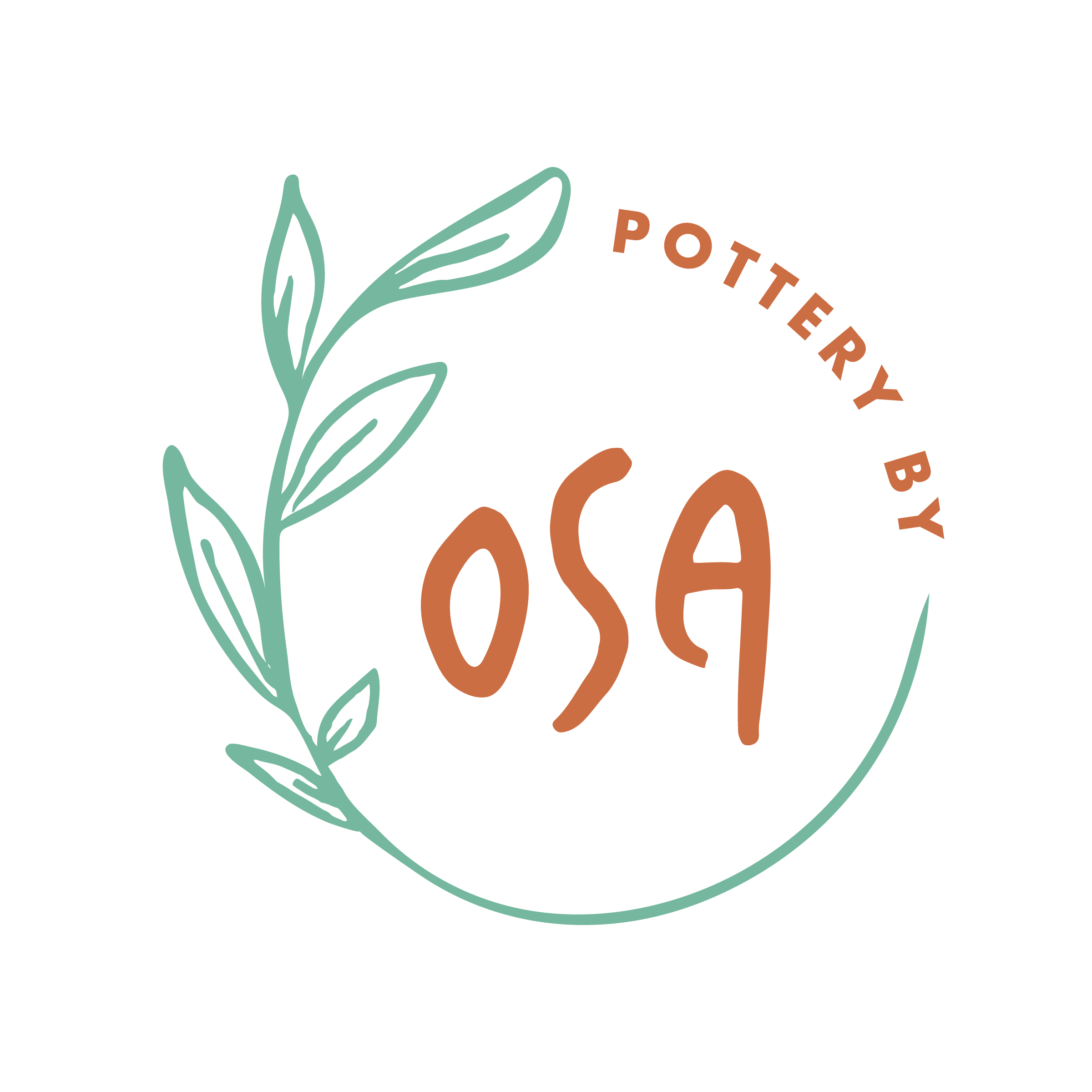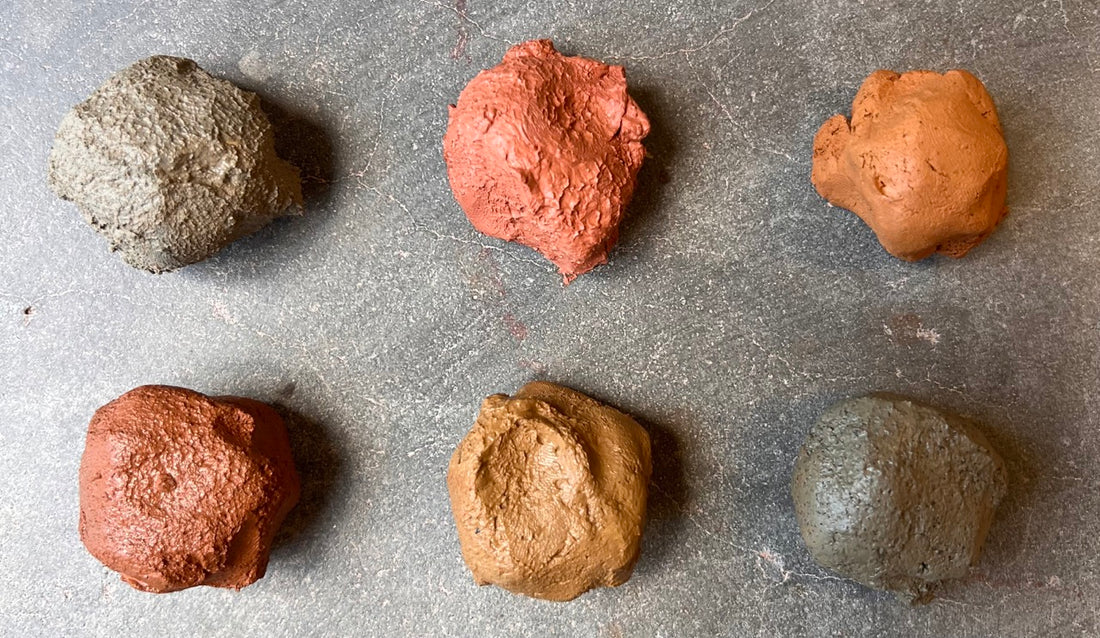Globally, it's common practice for ceramic artists to work with clay that they've dug themselves. But today, most people who work with clay in the United States use manufactured clay. The red stoneware I've used for years comes from a local clay manufacturer and distributor called Highwater Clays of Florida. Like other clay manufacturers, they create various clay bodies of different colors (earthen colors like white, brown, terracotta, black, etc.) and textures that fire to specific temperatures by combining processed mined materials into a perfectly even, plastic mixture.
Those clays have been formulated to create ease for the artist. I appreciate all of the labor and problem solving that goes into formulating a quality clay body, especially after processing wild clay myself! I don't have a consistent source for wild clay, anyway, so as much as it's captured my heart, I'll probably always rely on manufactured clay because it's readily available.
For the last several years, I've run into wild clay in various nature spots and it has slowly built into a burning need to make work with it.
Recently, I was brought a large amount of wild clay from a local construction site and it's the first time I've had wild clay in such quantity. What follows are examples I'd seen of clay in the wild before receiving that wonderful gift, a five gallon bucket of mud. I wanted to document and share these special finds as I turn the corner and beginning making my first batch of pottery with foraged wild clay from Florida.
I found clay in a natural setting for the first time in 2017. I had been working with clay for four years at this point and I was living in Baton Rouge, Louisiana, a sprawling southern college town covered in trees. My husband and I used to visit the many different parks in and around the city and one day discovered clay in both the low lying creek beds (left photo) and the land above (right photo.)


I would make little pinch pots in the woods and leave them behind. The pebbles of clay in the creek beds were marbled like steak, perfectly smooth and plastic (or moldable). The other clay was more of a brownish mustard color, also very plastic but full of rocks, plant roots and other organic material. At some point, I brought home maybe a pound or so to experiment with and fire. Both clays fire to a brick red color at cone 5 (over 2100°F).
As soon as you pick up a piece of wild clay, you begin to learn about it.
You feel the weight of it, you see the color, you experience the texture by pinching it between your fingers, you test the limits of its plasticity by rolling a coil. Then, if you're me, you take it home and fire a little piece. How high can I fire it before it melts into a puddle? How does the color change? Does it crumble? Does it crack when it dries or when it's fired? What is the fired surface like? Through our powers of observation we build our knowledge of wild clay.
I went to Arrowmont for a week long residency called Pentaculum in January 2019. While we were there, potter and teacher Lindsay Rogers took us up a hill behind the ceramics studio and showed us that there was clay. We took turns digging and filling a small bucket of iron-rich dark orange clay from the hill, brought it back to the studio and tried to work with it. Lindsay showed us how to slake it down (or turn the clay into a liquid by blending with water) and sieve it through window screen to get rid of rocks and roots. She then dehydrated the slurry on a plaster slab until it was at a consistency suitable for wheel throwing, wedged up about a pound of it and attempted to throw it on the wheel.
Her attitude was easy and playful.
She was curious about how the clay behaved and not at all disappointed to find that the clay didn't hold up very well to wheel throwing and wanted to collapse the whole way through. Forming a small bowl on the wheel with that wild clay threatening to split apart, Lindsey was like a kid trying to keep her balance on a merry go round. For me, it was the perfect initial approach to using wild clay.
This is what the clay around Arrowmont School of Crafts looks like (below). The school is located in the Smoky Mountains of Tennessee. I've tested it, and this clay can be fired all the way up to cone 10 (over 2300°F) and probably higher. This clay fires to shades of terracotta and brick red up through cone 8 and then fires to black at cone 10. (Bottom photo shows unfired clay sample (left) and samples fired to cone 5, 8 and 10.)


I moved to Sarasota, Florida in 2020 and live walking distance to Sarasota Bay. A thing you commonly hear is that there is no clay in Florida, but one day I was out walking by the bay and I ran into a guy who seemed to be looking for something. I asked him what it was and he said, "Fossils," and showed me some sharks teeth and bone fossils he'd just found that morning. As it turns out, he's a fifth generation Sarasotan and his dad showed him how to identify fossils when he was a child. He has a gigantic collection at his house. He also told me he used to find clay all of the time around the bay and would play with it when he was small.
Incredulous, I told him, "Everyone says there's no clay around here." He told me he was certain there was and he would show me.
A short time later during low tide, he walked me down shore and pointed out some clay at the base of a tall tree. Most of the shore has been developed, with retaining walls creating a clean boundary between people's backyard lawns and the bay. This instance of wild clay remained because that small portion of the shore was natural. It is such a special place.


Once I learned that clay was naturally abundant, I started noticing it everywhere. I've found some in a park about an hour north of where we live, I've found it in dirt roads outside of Gainesville and while kayaking through springs. For me, it's the same as plant identification; it's just another layer of the natural environment I get to observe and enjoy. I just like to find it, collect tiny amounts, fire small test samples, and experience surprise at the color change that clay often undergoes when it becomes ceramic.
The most majestic natural clay experience for me was in 2022 on Cape Cod. We found a cascade of gray clay pouring down onto the beach from the small cliff above. The incredible thing about this clay, aside from the beautiful setting in which it exists, is that it is self-glazing when fired.



These cups are made out of the clay found on Cape Cod. The cup on the left is unfired, the cup on the right is fired to cone 5. It is fully vitrified and sealed, all on its own. Historically, salt has been used to glaze pottery, often with a solution sprayed into the kiln at peak temperature. In this case, the salt from the ocean combined with the silica in the clay to create a sheer, glassy coating.


A lot of ceramicists conflate wild clay with earthenware and assume it can only be fired to low temperatures, but as far as I've found, that is untrue.
I think we get that idea from looking at indigenous and historical pots that were fired in open fires and pits. They are often lightweight and extremely porous due to being fired at temperatures we consider low. But all of the clays I've tested actually do fire to higher temperatures, above cone 5. Just because these clays were fired at low temperatures historically, doesn't mean that they are low fire clays. That is why one of the first things I do with any wild clay I find is see how high I can fire it. I like to push it as high as it will go just to see where that line is.
In my next post, I'll explain a bit of the process behind working with the local wild clay I was recently given.


4 comments
I vividly remember going to the beach with my family here in Florida and playing with a gorgeous clay that was a dark grey but also blue-green. I have a goal of trying to find that beach! Recently, I found a spring with some areas of a light colored clay and dark. Looking forward to processing it.
I recently discovered clay near my home in WA State. I ran home and grabbed a bucket and I’m getting ready to process it. So happy to find you!
That would be very cool to find a random little pinch pot in the woods. This is all so interesting.
This is just fascinating!!